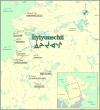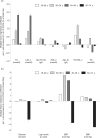Omega-3 polyunsaturated fatty acid profiles and relationship with cardiometabolic risk factors in Cree (Eeyouch) of Northern Québec
- PMID: 27427488
- PMCID: PMC4947832
- DOI: 10.3402/ijch.v75.30361
Omega-3 polyunsaturated fatty acid profiles and relationship with cardiometabolic risk factors in Cree (Eeyouch) of Northern Québec
Abstract
Background: n-3 long-chain polyunsaturated fatty acids (LC-PUFAs) from fish are known modulators of cardiometabolic risk factors.
Objective: To examine fatty acids (FAs) status and the relationship between n-3 LC-PUFA and cardiometabolic risk factors in Cree participants.
Design: We analyzed data from a cross-sectional study (n=829) conducted in Cree adults (aged 18-74 years) from 7 communities of the James Bay territory of Quebec (Canada) in 2005-2009. Sociodemographic, lifestyle, clinical and anthropometric data were collected. FAs were quantified in red blood cells (RBCs) under fasting conditions.
Results: A total of 89% of the participants were overweight (with 69% obesity), 33% had hypertriglyceridemia, 44% had low plasma HDL-c and 77% had fasting plasma insulin ≥90 pmol/l. Total n-3 PUFAs accounted for 6% of total FAs and were higher among older participants, while n-6 PUFAs accounted for 31% of total FAs and were higher among younger participants. According to the adjusted multiple linear regression models, n-3 LC-PUFA was associated (p<0.05) with higher total cholesterol, LDL-c and apo B-100, and was also associated (p<0.05) with lower blood glucose.
Conclusion: Overall, this study showed that n-3 LC-PUFA levels measured in the RBCs of the Cree adults are relatively low and tend towards lower levels among youth. These levels might be insufficient to offset the prevalence of cardiometabolic risk factors.
Keywords: James Bay Cree; blood glucose; cardiovascular disease risk factors; fish; lipids; nutritional transition; polyunsaturated fatty acids; traditional food.
Figures


Similar articles
-
Cardiovascular disease risk factors and n-3 fatty acid status in the adult population of James Bay Cree.Am J Clin Nutr. 2002 Jul;76(1):85-92. doi: 10.1093/ajcn/76.1.85. Am J Clin Nutr. 2002. PMID: 12081820
-
Association of red blood cell n-3 polyunsaturated fatty acids with plasma inflammatory biomarkers among the Quebec Cree population.Eur J Clin Nutr. 2014 Sep;68(9):1042-7. doi: 10.1038/ejcn.2014.125. Epub 2014 Jul 16. Eur J Clin Nutr. 2014. PMID: 25028086
-
Decreased activity of desaturase 5 in association with obesity and insulin resistance aggravates declining long-chain n-3 fatty acid status in Cree undergoing dietary transition.Br J Nutr. 2009 Sep;102(6):888-94. doi: 10.1017/S0007114509301609. Epub 2009 Apr 2. Br J Nutr. 2009. PMID: 19338705
-
Plasma n-3 fatty acids and psychological distress in aboriginal Cree Indians (Canada).Public Health Nutr. 2009 Dec;12(12):2343-51. doi: 10.1017/S1368980009004935. Epub 2009 Feb 26. Public Health Nutr. 2009. PMID: 19243672
-
Quality of diet is associated with insulin resistance in the Cree (Eeyouch) indigenous population of northern Québec.Nutr Metab Cardiovasc Dis. 2015 Jan;25(1):85-92. doi: 10.1016/j.numecd.2014.08.002. Epub 2014 Aug 28. Nutr Metab Cardiovasc Dis. 2015. PMID: 25240691
Cited by
-
Blood and hair mercury concentrations among Cree First Nations of Eeyou Istchee (Quebec, Canada): time trends, prenatal exposure and links to local fish consumption.Int J Circumpolar Health. 2018 Dec;77(1):1474706. doi: 10.1080/22423982.2018.1474706. Int J Circumpolar Health. 2018. PMID: 29785879 Free PMC article.
-
Health measures of Eeyouch (Cree) who are eligible to participate in the on-the-land Income Security Program in Eeyou Istchee (northern Quebec, Canada).BMC Public Health. 2021 Mar 31;21(1):628. doi: 10.1186/s12889-021-10654-7. BMC Public Health. 2021. PMID: 33789644 Free PMC article.
References
-
- Delormier T, Kuhnlein HV. Dietary characteristics of Eastern James Bay Cree women. Arctic. 1999;52:182–7.
-
- Santé Québec. Montréal: Ministère de la Santé et des Services Sociaux, Gouvernement du Québec; 1994. A health profile of the Cree: report of the Santé Québec health survey of the James Bay Cree, 1991.
-
- Statistics Canada. Aboriginal population profile, 2006 census. Statistics Canada catalogue no. 92-594-XWE. Ottawa; 2007 [cited 2014 Jan 17]. Available from: http://www12.statcan.ca/census-recensement/2006/dp-pd/prof/92-594/index.....
-
- Johnson-Down LM, Egeland GM. How is nutrition transition affecting dietary adequacy in Eeyouch (Cree) adults of Northern Quebec, Canada? Appl Physiol Nutr Metab. 2013;38:30–5. - PubMed
-
- Nolin B, Blanchet C. Canadian community health survey, cycle 2.1. Iiyiyiu Aschii, 2003. Food habits, physical activity and body weight. Conseil cri de la santé et des services sociaux de la Baie James, Institut national de santé publique du Québec (Eds); 2008 [cited 2016 Mar 26]. Available from: https://www.inspq.qc.ca/node/2831.
Publication types
MeSH terms
Substances
LinkOut - more resources
Full Text Sources
Other Literature Sources
Molecular Biology Databases
Research Materials
Miscellaneous
